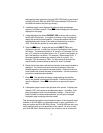
The eight page types for the left side are the following:
Page Annunciation
Knob Annunciation Page Name Page Numbers
TRI TRIP Trip Planning 0 - 6
MOD MODE Mode 1 - 2
FPL FPL Flight Plan 0 - 25
NAV NAV Navigation 1 - 5
CAL CALC Calculator 1 - 7
STA STAT Status 1 - 4
SET SETUP Setup 0 - 9
OTH OTHER Other 0 - 4 *
* up to 10 with fuel management system and air data interfaces
The ten page types for the right side are the following:
Page Annunciation
Knob Annunciation Page Name Page Numbers
CTR CTR Center Wpt. 1 - 2
REF REF Reference Wpt. None
ACT ACTV Active Wpt. **
D/T D/T Distance/Time 1 - 4
NAV NAV Navigation 1 - 5
APT APT Airport Wpt. 1 - 8
VOR VOR VOR Wpt. None
NDB NDB NDB Wpt. None
INT INT Intersection Wpt. None
SUP SUPL Supplemental Wpt. None
** Varies with the type of waypoints in the active flight plan
2.2 Entering Waypoint Identifiers
Waypoints are stored in the database by their ICAO (International Civil
Aviation Organization) identifiers. To use these waypoints it is only neces-
sary to enter the ICAO identifier of the waypoint, thus saving the labor of
entering a latitude and longitude.
One area of potential confusion is airport identifiers in the Continental
United States, Alaska, and Canada. Many airports in these three areas
use identifiers having four letters beginning with a prefix letter that corre-
sponds to the geographic area in which it is located. The prefix letter of
the Contiguous United States is “K”. Thus, the identifier for Los Angeles
International airport is KLAX, not LAX, which is the identifier of Los
Angeles VOR. Not all airport identifiers receive the prefix letter. Airport
identifiers which are a combination of letters and numbers do not receive
the prefix letter.
8


















